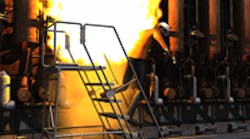Five workers died and three were injured in three separate incidents at Hoeganaes Corp.'s Gallatin powdered metals plant in 2011. When fine particles of iron dust ignited on Jan. 31, two workers were burned and later died from their injuries. On March 29, a similar flash fire burned another employee. Finally, on May 27, a hydrogen explosion at the plant shook loose iron dust accumulations, which ignited and rained down on workers. The explosion and ensuing fire killed three employees and injured two others.
"The three accidents at the Hoeganaes facility were entirely preventable. Despite evidence released by the CSB and information that Hoeganaes had in its possession even before the first accident in January 2011, the company did not institute adequate dust control or housekeeping measures," said CSB Chairperson Rafael Moure Eraso.
According to CSB, significant amounts of the fine iron powder had accumulated over time in the facility and the company did not reduce the hazards through engineering controls and basic housekeeping. Furthermore, the investigation found that Hoeganaes did not institute procedures such as combustible gas monitoring or provide training for employees on avoiding flammable gas fires and explosions. CSB also found that the company did not require atmospheric testing for hydrogen or other explosive gases.
Recommendations
Following its investigation, CSB issued several safety recommendations, including urging OSHA to develop and publish a proposed combustible dust standard within 1 year and ensure that the new standard includes coverage for combustible iron and steel powders.
CSB is recommending that the International Code Council, which sets safety standards that may be adopted by state and local governments, revise its standards to require mandatory compliance and enforcement with the detailed requirements of NFPA standards related to preventing accumulation of combustible dust in workplaces. Additionally, CSB is recommending that the City of Gallatin require all facilities covered by the International Fire Code to conform to NFPA standards for combustible dusts.
Among other recommendations, CSB's report advised Hoeganaes to conduct periodic, independent audits of the facility for compliance with NFPA standards; develop training materials that address combustible dust hazards; and develop and implement a near-miss reporting and investigation policy. CSB also made recommendations to the Metal Powder Producers Association, the Gallatin Fire Department and City of Gallatin.
Finally, CSB's new safety video, "Iron in the Fire," features computer animations depicting each accident at the Hoeganaes facility.
Hoeganaes Makes Changes
According to a statement from Hoeganaes sent to EHS Today, the company ceased production after the third accident and initiated a comprehensive safety review with the help of two external firms.
"The objective of the review was to ensure that the root cause of the three incidents was fully understood and any corrective action implemented," the company stated. "In addition, to make recommendations which would take the Gallatin facility far beyond regulatory compliance to world class standards of operations and safety. These corrective actions have been taken to ensure that similar accidents will not happen again."
Hoeganaes implemented the recommendations, which included upgrading electrical systems, replacing the gas and air supply system in the affected building, implementing upgraded gas management and hydrogen detection systems, developing an industry-leading powder metal dust management system, upgrading furnaces and conducting comprehensive retraining for all employees.
"Dust fires and explosions continue to claim lives and destroy property in many industries," said Moure Eraso. "More must be done to control this hazard. No more lives should be lost from these preventable accidents."
For more information about the investigation, visit http://www.csb.gov/investigations/detail.aspx?SID=100&Type=2&pg=1&F_All=y.


